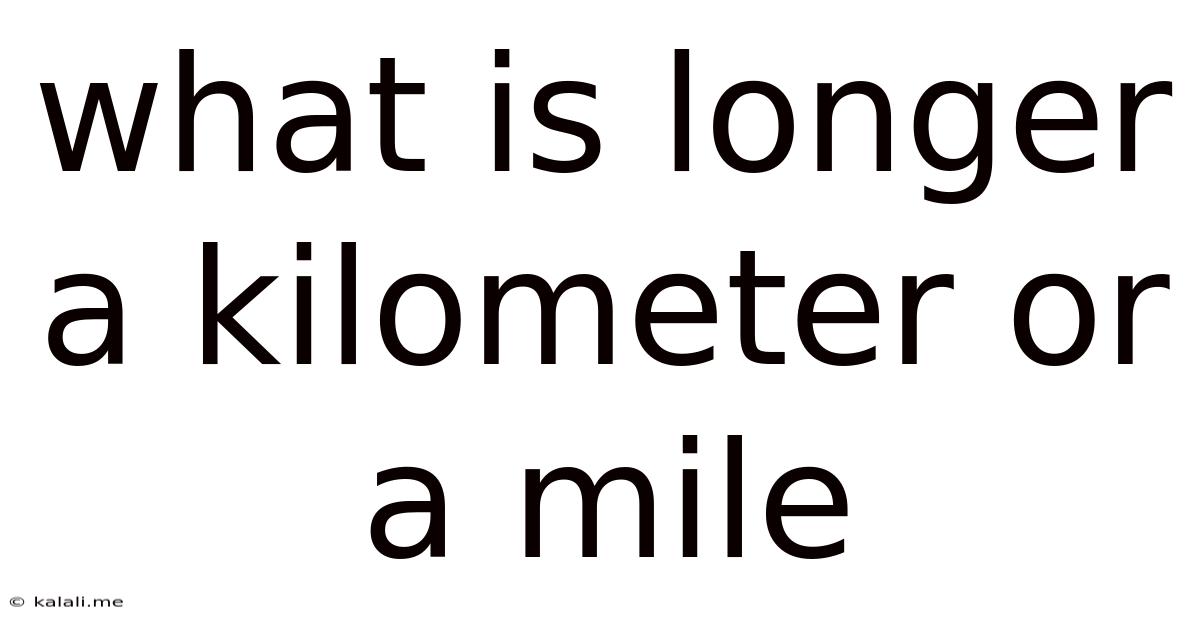What Is Longer A Kilometer Or A Mile
Kalali
Jul 15, 2025 · 4 min read

Table of Contents
Kilometer vs. Mile: Unveiling the Distance Difference and Practical Applications
Are you ever confused about the difference between a kilometer and a mile? These two units of measurement, commonly used to express distance, often leave people wondering which one is longer. This comprehensive guide dives deep into the comparison of kilometers and miles, exploring their origins, conversion factors, practical applications, and even their historical context within different systems of measurement. By the end, you’ll not only understand the simple answer but also gain a nuanced appreciation for the practical implications of this seemingly small difference in measurement.
Understanding the Fundamentals: Kilometers and Miles Defined
A kilometer (km) is a unit of length in the metric system, equal to 1000 meters. The metric system, known for its simplicity and decimal-based structure, is widely used globally for its ease of conversion between units. It's a system characterized by prefixes that denote multiples of ten, making calculations straightforward.
A mile (mi), on the other hand, is a unit of length in the imperial and US customary systems. Its origins are less precise, evolving over time from the Roman mille passus (a thousand paces). Unlike the kilometer's clean decimal relationship with the meter, the mile's relationship to other units within its system is less straightforward, leading to complexities in calculations.
The Key Difference: Which is Longer?
The simple answer is: a mile is longer than a kilometer. Specifically, one mile is approximately equal to 1.609 kilometers. This means that a kilometer is roughly 0.621 miles. This seemingly small difference in length can accumulate significantly over longer distances. Imagine running a 5k race versus a 3-mile race – the mile race is considerably longer.
Historical Context and Global Usage
The prevalence of kilometers versus miles reflects the geographical and historical adoption of different measurement systems. Most countries worldwide have adopted the metric system, making the kilometer the standard unit for measuring distance. The United States, Liberia, and Myanmar are notable exceptions, where the mile remains the more common unit in everyday life, though even the US is increasingly using metric measurements in certain scientific and technical fields. This difference in usage leads to potential confusion when comparing distances across countries and regions.
Practical Applications and Everyday Examples
The difference between kilometers and miles has practical implications across various aspects of daily life:
- Road Signs and Maps: In countries using the metric system, road signs and maps display distances in kilometers. Conversely, in countries using the imperial system, miles are used. This requires awareness when traveling internationally or consulting maps from different regions.
- Sports and Fitness: Many running and cycling events are measured in either kilometers or miles. Understanding the conversion is crucial for comparing performance across events using different units. A 10k race is shorter than a 6-mile race.
- Aviation: While the metric system is predominantly used in aviation, some legacy systems and older aircraft might use miles, highlighting the persistence of both systems in specific industries.
- Navigation Systems: Modern GPS devices and mapping applications usually offer the option to display distances in either kilometers or miles, offering flexibility for the user based on their preference and location.
- Real Estate: Property sizes and distances are expressed differently depending on the country. Understanding the conversion is crucial when comparing properties in different regions.
Conversion Factors and Calculations
The conversion between kilometers and miles requires a simple multiplication or division:
- Kilometers to Miles: Multiply the number of kilometers by 0.621.
- Miles to Kilometers: Multiply the number of miles by 1.609.
While simple, accurate conversions are essential to avoid misunderstandings, especially in contexts like travel planning, sports performance tracking, or engineering calculations.
Beyond the Basic Conversion: Deeper Insights into Measurement Systems
Understanding the difference between kilometers and miles extends beyond a simple conversion. It's a window into the broader world of measurement systems. The metric system's inherent simplicity and consistency make it highly efficient for scientific and technical applications. The imperial system, while less efficient, maintains its presence due to historical reasons and entrenched usage in certain countries.
The Future of Measurement: A Converging World?
While the imperial system persists in some regions, the global trend leans towards the increasing adoption of the metric system. This is particularly true in science, technology, and international trade, where a universal system simplifies communication and collaboration. While complete global standardization remains a distant goal, the simplification offered by the metric system is increasingly prevalent.
Conclusion: A Comprehensive Understanding of Distance Measurement
This detailed comparison of kilometers and miles highlights the importance of understanding different units of measurement and their practical applications. Knowing that a mile is longer than a kilometer is only the first step. A deeper understanding of the origins, usage, and conversion factors allows for accurate calculations, clear communication, and a broader appreciation for the history and evolution of measurement systems. Regardless of the unit used, understanding distance measurement is crucial in various aspects of our lives, from daily commutes to international travel, and from athletic competitions to scientific research. The ability to easily convert between kilometers and miles is an invaluable skill in an increasingly interconnected world.
Latest Posts
Latest Posts
-
How Many Grams Is One Cup Of Cooked Rice
Jul 16, 2025
-
Purchase Order Processing Requires Distributing Allocating And Executing Funds
Jul 16, 2025
-
7am To 10pm Is How Many Hours
Jul 16, 2025
-
What Does A Triangle In A Circle Mean
Jul 16, 2025
-
How Many Square Feet Is A 1 4 Acre
Jul 16, 2025
Related Post
Thank you for visiting our website which covers about What Is Longer A Kilometer Or A Mile . We hope the information provided has been useful to you. Feel free to contact us if you have any questions or need further assistance. See you next time and don't miss to bookmark.